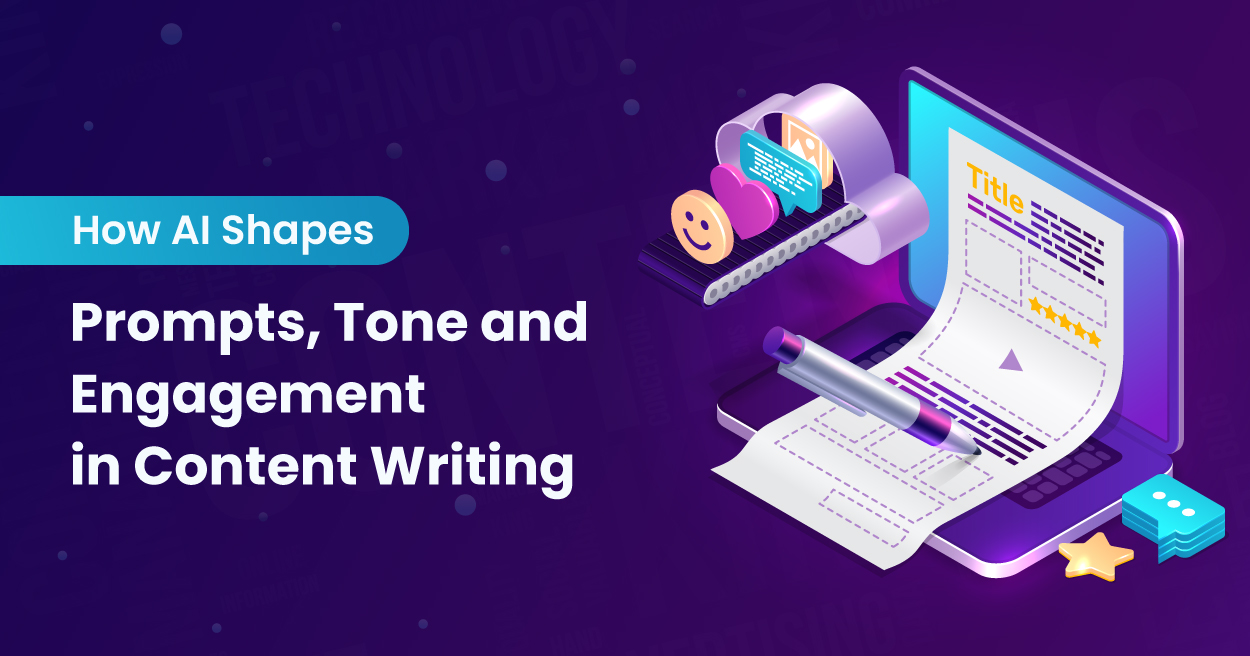
“From prompts to prose and tones that delight, AI’s creative sparks shine ever so bright. Behind the code, a muse unseen, in the realm of algorithms, creativity convenes.”
Believe it or not, these lines are generated by AI. Welcome to the world where technology has partnered with imagination. In this 4th blog of our AI Series, we will talk about how AI shapes prompts, tones, and engagement and explore its creative algorithm that’s redefining human expression.
How AI Perceives Human Intent
AI prompts are powerful tools that leverage AI and machine learning algorithms to comprehend patterns and associations in data, allowing them to generate human-like responses. These prompts employ NLP algorithms to generate content based on the input or prompts.
Oh, wait! Have you heard about NLP and engineering? These are essential players in the AI and machine learning arena!
NLP is a subfield of AI dedicated to making computers understand, interpret, and even produce human language. It bridges the gap between human communication and computer comprehension and plays a vital role in various applications like machine translation, sentiment analysis, and conversational AI.
On the other hand, Prompt engineering, a subset of NLP, involves designing and optimizing prompts to communicate with AI language models effectively. Think of it as the art of asking questions or giving directions to AI in a way that prompts the most relevant and accurate responses.
Confusing? Aghh, let’s make it easier for you.
AI prompts use NLP to reply based on the given prompt. NLP helps them understand patterns in text from sources like social media or news. Once a prompt is given, the AI prompt model uses its learned patterns to create a response that fits the context. This process is known as “Interface” and calculates the word probabilities from training data and the prompt.
Crafting Tone and Style
“AI’s got more style transitions than a fashion show runway – it’s like it’s mastered the art of being a whole writing squad.”
Hold up a sec! Imagine how Shakespeare would express the lines above.
“Verily, AI hath transitions of style more than a runway for fashion, akin to mastering the art of a scriptorium with a manifold quill.”

Source: ChatGpt
Now, let’s pull back the curtain and see how this tech genius does its style imitation magic.
Ai’s abilities are not limited to only basic generation; it excels in adaptability, refining itself, and imitating different styles.
Adaptability: With a combination of training data and pattern recognition, AI can adjust its tone and style to generate answers to fit different situations. It’s like a language expert that adjusts how it responds based on what’s happening. This adaptability is particularly evident in AI-powered chatbots and customer service interaction, where the same AI can transition from formal to casual language based on the conversation.

Source: ChatGpt
Fine-Tuning: AI’s initial training is based on a vast dataset, but the real magic comes from fine-tuning. Fine-tuning refines AI’s output and makes it more relevant and aligned with the desired result. This process aids in AI’s ability to deliver personalized content.
Style Imitation: AI’s style imitation is like an artist mastering different brush strokes. AI can learn different writing styles by analyzing existing works and be like Shakespeare or a modern journalist. This allows AI to generate content that resonates with specific audiences and imitates the required tone and style.
The Science of Engaging Content
When it comes to captivating an audience, there’s much more than meets the eye. It’s not just about crafting words, but instead, it’s about understanding what resonates with the reader. This is where AI comes into action, coupled with its linguistic analysis and user behavior prediction.
Creating engaging content isn’t a magical trick; instead, it’s an intelligent science propelled by AI. Creating engaging content involves AI’s proficiency in linguistic analysis and user behavior prediction to craft content that resonates effectively. Let’s get you to the mechanics of this approach supported by some examples.


Fun Fact: Courage the Cowardly Dog was rocking OpenAI way before we jumped on the tech train!
Linguistic Analysis: AI content generation is built on the foundation of linguistic analysis. It is like a digital language detective that carefully decodes how words connect, the sentiments they evoke, and the context in which they prosper.
The User Behaviour Perspective: AI’s prediction capabilities are not just limited to content analysis but also extend to user behavior and engagement trends prediction. With an analysis of historical interactions, AI gains insights into their preferences. This predictive capability allows AI to anticipate what content will likely resonate more with the audience.
Let’s simplify this, shall we?
AI’s Synergistic Approach: The combination of linguistic analysis and user behavior prediction is essential for AI to produce engaging content. As AI’s understanding of language nuance and user preferences grows, its ability to deliver personalized, captivating content becomes its defining characteristic.
Ethical Considerations
Have you heard? An experiment was conducted to check if people could differentiate between human-written and AI-generated content. Results revealed that participants struggled to distinguish them apart!
Now that we have explored how AI shapes the prompts, tones, and engagement in content writing, let us shift our focus toward the ethical concerns that come into play. While AI enhances content creation, concerns about originality, plagiarism, transparency, and bias arise. We must find a fair balance between its help and the human touch to address these.
We should be open about AI’s role, watch for mistakes, and ensure what’s created is accurate and fair. When it comes to engaging people, AI is handy, but real human connections matter, too. It’s about combining AI’s strengths with genuine human interaction in an ethical way.
It’s Time for the Grand Finale—Ta-Da!
With technology and imagination, AI’s creativity reshapes content from prompts to engagements. AI’s ability to understand human intent through NLP prompts, adapting styles, and predicting behavior is a game changer in content creation. However, ethical concerns remind us to balance AI’s power with the authenticity of human connection. Within this coming together, AI enhances our creativity, but the human element remains essential.



